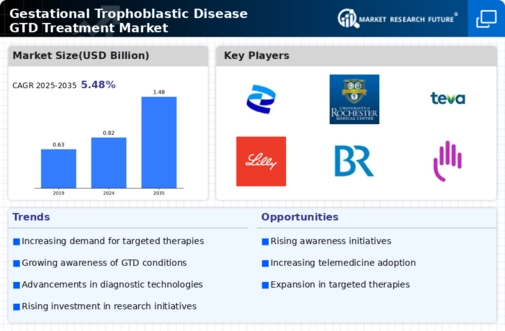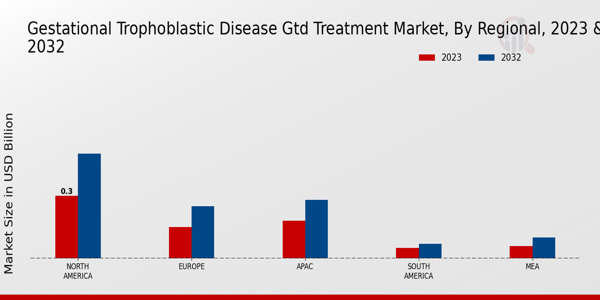Increasing Incidence of GTD
The rising incidence of Gestational Trophoblastic Disease GTD is a primary driver for the Global Gestational Trophoblastic Disease GTD Treatment Market Industry. Recent statistics indicate that GTD affects approximately 1 in 1,000 pregnancies, with variations across different regions. This increasing prevalence necessitates enhanced treatment options and healthcare resources, contributing to market growth. As awareness of GTD improves, more cases are diagnosed, leading to a projected market value of 0.82 USD Billion in 2024. The growing patient population is likely to stimulate demand for innovative therapies and management strategies, thereby expanding the overall market landscape.
Government Support and Funding
Government support and funding for research and treatment of Gestational Trophoblastic Disease GTD are pivotal in driving the Global Gestational Trophoblastic Disease GTD Treatment Market Industry. Various health authorities are allocating resources to improve diagnostic tools and treatment protocols, which can enhance patient care. For example, funding initiatives aimed at developing new therapies and clinical trials are likely to yield innovative solutions for GTD management. This financial backing is expected to bolster market growth, contributing to a projected market size of 0.82 USD Billion in 2024. As governments prioritize women's health issues, the market is poised for further expansion.
Rising Awareness and Education
The growing awareness and education surrounding Gestational Trophoblastic Disease GTD play a crucial role in shaping the Global Gestational Trophoblastic Disease GTD Treatment Market Industry. Increased educational initiatives by healthcare organizations and advocacy groups have led to better understanding and early detection of GTD. This heightened awareness encourages women to seek timely medical attention, which is essential for effective treatment. As a result, the market is anticipated to grow at a CAGR of 5.49% from 2025 to 2035, reflecting the positive impact of education on diagnosis and treatment rates. Enhanced awareness is likely to lead to improved patient outcomes and a more robust market.
Advancements in Treatment Modalities
Innovations in treatment modalities for Gestational Trophoblastic Disease GTD significantly influence the Global Gestational Trophoblastic Disease GTD Treatment Market Industry. Recent developments in chemotherapy regimens and surgical techniques have improved patient outcomes and reduced recurrence rates. For instance, the introduction of minimally invasive surgical options has enhanced recovery times and reduced hospital stays. These advancements are expected to drive market growth, with a projected increase to 1.48 USD Billion by 2035. As healthcare providers adopt these new technologies, the market is likely to witness a shift towards more effective and patient-centric treatment approaches.
Market Trends and Growth Projections
The Global Gestational Trophoblastic Disease GTD Treatment Market Industry exhibits promising growth trends, with projections indicating a market value of 0.82 USD Billion in 2024 and an anticipated increase to 1.48 USD Billion by 2035. The compound annual growth rate (CAGR) of 5.49% from 2025 to 2035 reflects the increasing demand for effective treatments and the ongoing advancements in medical technology. This growth is influenced by various factors, including rising incidence rates, improved awareness, and government support. As the market evolves, stakeholders are likely to focus on innovative solutions to enhance patient outcomes and address the challenges associated with GTD.
Emerging Markets and Healthcare Infrastructure
Emerging markets with developing healthcare infrastructure present significant opportunities for the Global Gestational Trophoblastic Disease GTD Treatment Market Industry. Countries in Asia and Africa are witnessing improvements in healthcare access and quality, leading to better diagnosis and treatment of GTD. As these regions enhance their healthcare systems, the demand for effective GTD treatments is likely to increase. This trend is expected to contribute to the market's growth trajectory, with a forecasted value of 1.48 USD Billion by 2035. The expansion of healthcare facilities and services in these markets may facilitate earlier detection and improved management of GTD cases.
























